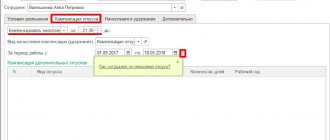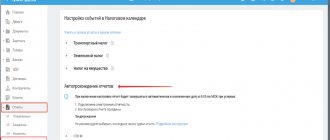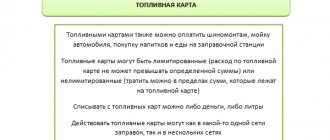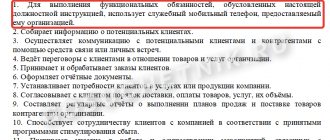The importance of keeping records and writing off fuel
The main expense item for a vehicle fleet is fuel. And competent, thoughtful accounting of fuels and lubricants in a transport organization is a priority task. A well-thought-out accounting policy, in parallel with the ongoing analysis of actual fuel consumption, will help reduce fuel losses and reduce the cost of its purchase by an average of 10–50%.
Of course, tax and accounting of fuel and lubricants has a lot of subtleties and it is impossible to cover all the details of this process in one material. Therefore, we will focus on the most important things and figure out how to organize the accounting of fuel and fuels and lubricants in such a way that it is extremely accurate and simple for the fleet owner.
Where to start working with a fuel and lubricants control system
The first step is to get your accounting in order. You need to understand how much fuel is purchased every month and how much fuel is consumed. It is easier to check this information using pay slips.
To speed up this process, you can enter the data received from the navigator into the 1C accounting system.
By doing this, you will solve a number of important problems:
- introduce new write-off rules after receiving actual indicators;
- compare information about the work plan, fuel costs, vehicle movement for different periods of time;
- record the remaining fuel after a work shift based on the mileage information on the odometer;
- obtain a record of the work performed by all employees of the enterprise.
For this system to “work”, two conditions are necessary: 1) reliable information; 2) timely reports on fuel consumption during the day, week, month.
The next step is to prepare a package of documents confirming that the company is engaged in transporting goods or transporting people. The package includes waybills, sales receipts, and invoices.
There is an important point at this point. The documents must indicate the make of the car, year of manufacture, mileage, fuel consumption per 100 km. The calculation of fuel and lubricants depends on this.
For example, a car made in 2006 with a faulty engine will consume more fuel than a foreign car made in 2019. New generation models have more economical fuel consumption.
Take into account the technical parameters of the vehicle, which determine how much fuel is needed for travel.
As for where to enter the costs of purchasing fuel, this data is recorded in:
a) statements intended for the material costs of the enterprise;
b) documents regulating additional expenses.
The actual amount of costs for the purchase of fuel and lubricants is included in the paper.
Fuel and lubricants accounting: actual and standard consumption
Accounting for fuels and lubricants in the organization is carried out with the mandatory use of pre-established consumption rates. These norms are used as economic justifications for tax and accounting reporting. And despite the fact that the Tax Code of the Russian Federation does not contain direct rules for writing off fuel and lubricants, representatives of the Tax Service may still require justification for fuel costs. It is beneficial for enterprises to rely on established norms, because this way they can reduce the amount of taxes paid (depending on the tax burden and form of ownership).
From the accounting side, it is better to indicate the actual costs of fuel and lubricants, because this approach will have a positive impact on financial performance. The best way out of the situation is to maintain a combined accounting of vehicle fuel. But regardless of the chosen accounting option, it is important to understand whether the established standards correspond to reality, because this is the only way to see the most complete and accurate picture of fuel accounting.
Two methods for calculating fuel standards
So, the accounting of fuels and lubricants in transport in vehicle fleets is carried out according to pre-calculated standards, which are prescribed in the documentation developed by the Russian Ministry of Transport. These standards are reflected in Order N AM-32-r “On the implementation of methodological recommendations “Standards for fuel and lubricant consumption in road transport.” The document is constantly edited and updated - the last time changes were made in 2022.
The current document contains information for different types of special equipment and vehicles (passenger cars and trucks). Formulas for calculating standards and correction factors are also reflected there. The latter take into account the condition of the roads, the time of year, the duration of use of the vehicle, the population of the specific region within which the car is moving and many other factors. Also, for each type of vehicle, correction factors are provided that take into account the cylinder volume and the type of fuel and lubricants used. All this greatly simplifies car fuel accounting.
Using the standards described above, fuel consumption can be determined using 2 methods:
- The simplest one
. Liters of fuel are divided by kilometers traveled, and then multiplied by 100. Afterwards, correction coefficients are applied. - Most accurate
. Accounting for fuels and lubricants in a transport company is carried out on the basis of a formula with consumption rates prescribed in N AM-32-r in relation to certain vehicles.
Option 2 is more complex, but allows you to keep track of vehicle fuel as accurately as possible. If we are talking about a passenger car, the calculation formula according to option 2 will be as follows:
Qh = 0.01 x Hs x S x (1 + 0.01 x D)
, Where:
- Qh—accepted norm;
- Hs is the basic consumption rate for every 100 km. paths;
- S—mileage of a passenger car;
- D—correction factor relative to the norm, in percent.
In order to always document the most accurate accounting of fuel and lubricants for a car, it is worth using not only this formula, but also technical documentation for a specific car brand, and then applying coefficients for corrections. This accounting method has a significant advantage - all the standards of the Ministry of Transport were carefully calculated and thought out. They are also constantly reviewed and updated.
But there are some downsides here:
- like “passport” standards, the indicators of the Ministry of Transport are extremely general;
- fuel consumption is influenced by a lot of factors, which in turn affect each vehicle differently;
- the more mileage a car has and the longer the car operates, the values in the standards will increasingly diverge from reality;
- under various factors (weather conditions, technical condition of the car, etc.), the fuel consumption of the same car (even with the same adjustments) will differ.
Excessive fuel consumption in vehicles: accounting and tax accounting
Emphases of this article:
- fuel consumption standards for vehicles are established by current legislation;
- increasing or decreasing adjustment factors are applied to the basic standards;
- When writing off fuel in accounting, you need to compare the actual and standard fuel consumption.
Almost every enterprise uses vehicles in its business activities. Actual fuel consumption often differs from the established norm. The reasons for overconsumption can be very different: weather conditions, road conditions, vehicle mileage, as well as irrational use of fuel by the driver. Therefore, the question arises: by what standards should fuel be written off? And how to reflect excess fuel consumption in accounting and tax accounting? You will find answers to these questions in the consultation.
Standards for fuel and lubricant consumption on vehicles
The consumption standards for fuel and lubricants for cars were approved by Order of the Ministry of Transport dated February 10, 1998 No. 43 (hereinafter referred to as Standards No. 43). It contains basic linear fuel consumption rates for more than 1,200 car models (modifications), fuel consumption rates for transport work and for the operation of special equipment, as well as a system of adjustment coefficients for standard fuel consumption.
According to clause 1.1 of Standards No. 43, enterprises can use the following standards and adjustment factors:
- basic linear norm for car mileage;
- standard for performing transport work;
- norm per ton of curb weight;
- norm for one trip with cargo;
- mileage allowance when performing special work;
- standard for the operation of special equipment installed on vehicles;
- basic standard for the operation of an autonomous (independent) heater.
Reducing and increasing coefficients
Various correction factors are applied to fuel consumption standards, which increase or decrease the standards. The reasons leading to the use of such coefficients are given in table. 1 on next page.
If you need to apply several adjustment factors at the same time, then you must calculate the total adjustment factor equal to the amount of such allowances.
Table 1
Printable table available on the page: https://uteka.ua/tables/3284-0
| Reasons leading to the use of adjustment factors for fuel consumption standards | |
| Increasing consumption rates (clause 3.1 of Standard No. 43) | Reducing consumption rates (clause 3.2 of Standard No. 43) |
| 1 | 2 |
| Work in the cold season. Work in mountainous areas and/or on routes with hilly terrain. Working on roads with complex layouts. Work in urban environments. Work with frequent stops. Work that requires slowing down. Work in quarries, driving through fields, forest or steppe areas. Work in extremely difficult road conditions. Operation of new cars and engines. Driving in a car with a long service life. Hourly work of trucks. Training ride. The need to maintain comfortable temperature conditions in the cabin. Driving on public roads outside the city and on roads passing through populated areas. Use of special vehicles equipped with special audio alarms to perform urgent work tasks | Work outside populated areas on public roads. Operation of city buses on a custom basis or for another purpose, but not on regular routes. Enterprise management decision |
Accounting and tax accounting
In accounting, the cost of consumed fuel is reflected depending on the purpose of using vehicles and is written off from the credit of subaccount 203 “Fuel” to the debit of the corresponding subaccounts (15, 20, 23, 28, 91–94).
In tax accounting, the rules for recognizing expenses are described in clauses 138.4, 138.5 of the Tax Code (hereinafter referred to as the Tax Code):
- expenses that form the cost of goods sold, work performed, services provided are recognized as expenses of the reporting period in which sales income is recognized;
- other expenses are recognized as expenses of the reporting period in which they were incurred.
From this follows the conclusion:
- the cost of fuels and lubricants included in the cost of manufactured products (work performed, services provided) and in the initial cost of purchased goods will be included in the enterprise’s expenses only in the period of recognition of income from the sale of such products (goods, works, services);
- costs for the purchase of fuel and lubricants, the cost of which is included in other expenses of the enterprise (administrative, sales expenses, other operating expenses), are included in the calculation of the tax base in the period in which they were incurred (i.e., in the period of write-off of spent fuels and lubricants from the balance).
For tax accounting purposes, the most important thing is to prove that the mileage is economical. Thus, according to clause 138.2 of the Tax Code, tax expenses are recognized on the basis of primary documents confirming the actual expenses of the taxpayer and their connection with his business activities.
In addition, it is necessary to make a calculation and compare the standard and actual fuel consumption. If the actual consumption does not exceed the norm, then the entire cost of actually consumed fuel is easily included in the enterprise’s expenses. If the actual consumption exceeds the standard, then you can only include the cost of fuel and lubricants within the norms in tax expenses (clauses “and” clauses 138.8.5, clause 140.3 of the Tax Code).
What VAT consequences arise in case of excess consumption of fuel and lubricants?
The enterprise will have to recognize a conditional supply for the amount of such overexpenditure, that is, accrue tax liabilities for VAT based on the cost of purchasing fuel (clause “d” of clause 198.5 of the Tax Code).
Is it necessary to include the cost of excess fuel consumption in the driver’s taxable income and withhold personal income tax accrued on the amount of excess consumption?
If excessive fuel consumption was not the fault of the employee, then there is no reason to withhold personal income tax.
However, overexpenditure that arose for objective reasons (difficult weather conditions, technical condition of the car, etc.) must be documented. For example, a report on the technical condition of the car with the conclusions of the commission, which indicates the reason for the overconsumption and the actual fuel consumption.
If it is proven that excessive fuel consumption was due to the employee’s fault, then the company can recover the cost of such fuel from him. For example, deduct the cost of gasoline from his salary. At the same time, we recommend that you prepare documents confirming the employee’s guilt: you need an explanatory note from the employee and his application to withhold this amount, as well as an order for disciplinary action.
And if the employee’s guilt is proven, but the company does not collect from him the cost of excessive fuel consumption, then the personal income tax accrued on the cost of overused fuel will have to be withheld from the employee. Indeed, in this case, the cost of gasoline will be considered an additional benefit received from the employer (clause 164.2.17 of the Tax Code). In this case, the tax base is determined taking into account the natural coefficient (clause 164.5 of the Tax Code).
Write-off of fuel in accounting
Example
At the Vesna LLC enterprise (located in Dnepropetrovsk), in November 2014, administrative personnel used a Mitsubishi Pajero car to perform official duties (travel around the city). According to the waybills, the fuel consumption was 350 liters (due to the technical condition of the car), the mileage was 1,660 km.
Using Standards No. 43, we calculate the standard gasoline consumption for this car:
basic linear rate - 14.8 l/100 km;
increasing coefficients:
– for work in the cold season – 2% (clause 3.1.1.1 of Standard No. 43);
– for work in urban conditions – 15% (clause 3.1.4 of Standards No. 43).
Standard fuel consumption according to clause 4.1 of Standard No. 43 is calculated using the formula
Q n = 0.01 x N s x S x (1 + 0.01 x K ∑ ),
where Qн – standard fuel consumption, l;
Н s – basic linear fuel consumption rate, l/100 km;
S – vehicle mileage, km;
K ∑ – total adjustment factor, %.
Let's substitute the values from our example into this formula:
Qn = 0.01 x 14.8 x 1,660 xx (1 + 0.01 x 17) = 287.45 l.
Thus, the overconsumption was 62.55 l (350 l - 287.45 l).
Let's reflect the data on overexpenditure in the table. 2.
table 2
Printable table available on the page: https://uteka.ua/tables/3284-1
| Name and price (UAH/l) | Actual quantity (l)/cost (UAH) | According to the norm: quantity (l)/cost (UAH) | Exceeding established standards (overconsumption) (l)/cost (UAH) |
| 1 | 2 | 3 | 4 |
| Gasoline – 15.00 | 350/5 250,00 | 287,45/4 311,75 | 62,55/938,25 |
Accounting and tax accounting for excessive fuel consumption
(UAH)
Printable table available on the page: https://uteka.ua/tables/3284-2
| No. | Contents of operation | Source documents | Accounting | Tax accounting | |||
| Dt | CT | Sum | Income | Expenses | |||
| 1 | 2 | 3 | 4 | 5 | 6 | 7 | 8 |
| 1 | Fuel written off | Waybill | 92 | 203 | 4 311,75 | – | 4 311,75 |
| 2 | Excessive fuel consumption reflected | Waybill, accounting registers | 947 | 203 | 938,25 | – | – |
| 3 | Tax liabilities for VAT have been accrued (938.25 x 20%) | Tax invoice | 947 | 641 | 187,65 | – | – |
1. Cost of excess fuel consumption:
in accounting – written off as other operating expenses;
tax accounting - is not included in expenses, since it is considered that such fuels and lubricants were not used in business activities. Also, the company must accrue VAT tax liabilities on the cost of overexpenditure.
2. If excessive fuel consumption was not the fault of the employee, then the reason for the excessive consumption must be documented and explained. Then the cost of “extra” fuel will not have to be withheld from the employee and subject to personal income tax.
Individual calculation of fuel consumption
An alternative to the options described above is accounting for fuel in tanks (or in car tanks) using a unique, developed system that will take into account all the standards, technical features, operating conditions of the car and other important parameters.
It is worth noting once again that the standards published by the Ministry of Transport are only methodological, comparatively comparable data. That is, they are not considered mandatory for use, and each vehicle fleet has the right to independently determine correction factors, based on the characteristics of its equipment. With this approach, nothing will prevent you from applying the coefficients proposed by the department in the future.
To develop your own fuel metering system for a fleet of vehicles, it is necessary to form a special commission, which should include company managers, technical specialists, and, of course, drivers.
This commission carries out control measurements of fuel consumption, which are based on:
- technical parameters of the machine;
- condition of the car;
- terms of use of the vehicle;
- seasons;
- etc.
The standards that will be obtained based on the work of such a commission are documented for each vehicle. The same standards will apply to the write-off of fuel and lubricants in a transport company. Such internal local documents can be edited, for example, when a company purchases new cars. But the main thing is to remember to document all changes in acts.
Of course, in reality, very few fleets develop their own fuel consumption standards. Either management lacks the desire, or there is a lack of experience and understanding of all the intricacies of the process. Although in this matter it is quite easy to find those who can provide competent support and assistance. Even a service station employee can partially cope with this task.
Specialized companies that install satellite fuel monitoring systems (for example, GLONASS fuel accounting) take the task as seriously as possible. In any case, you need to understand that with properly organized accounting and write-off of fuel and lubricants for special equipment, you can avoid excessive fuel consumption by as much as 20%.
Accounting for fuels and lubricants in 1C 8.3 step-by-step instructions
In an organization, accounting and write-off of fuel and lubricants consists of:
- receipts;
- distribution (if fuel and lubricants are purchased centrally);
- spending;
- write-offs.
Let's consider the table for registration of accounting and write-off operations for fuel and lubricants in 1C 8.3.
| the name of the operation | Documents (reports) in 1C |
| Purchasing fuel and lubricants centrally | |
| Acceptance of registration by invoice | Receipt (act, invoice) - Goods (invoice) |
| Purchasing fuel and lubricants through an accountant | |
| Acceptance of registration according to advance report | Advance report - Products tab |
| Distribution of fuel and lubricants among vehicles | |
| Refueling a car with fuel and lubricants using coupons, when ownership of the fuel has transferred after the advance payment | Movement of goods - Goods tab (fuel and lubricants in gas station tanks - Auto warehouse) |
| Refueling fuel and lubricants from the organization's warehouse | Movement of goods - Goods tab (fuel and lubricants in tanks - Auto warehouse) |
| Accounting for fuel consumption | |
| Travel expenses | Waybills (with the Waybills ) |
| Write-off | Requirement - invoice, waybill |
As you can see, one of the most important procedures: accounting for the consumption of fuel and lubricants is not reflected in 1C 8.3 Accounting 3.0 when the Waybills . Only the result of this operation is reflected there - writing off fuel according to waybills in 1C 8.3.
Fuel measuring methods
Among the most common methods for measuring fuel in a vehicle tank are the following:
- installing a measuring tank on the fuel system;
- use of a probe with a scale;
- draining fuel and lubricants into special measuring containers.
The measurement results of the chosen method will always be affected by permissible errors. And in order to always obtain the most accurate measurement results, it is worth using a combination of the methods described above and accounting for fuel and lubricants using GLONASS data to compare the data obtained. At the same time, each vehicle must be equipped with a fuel level sensor and an BC (on-board controller) in order to keep accurate records of fuel and lubricants. Equipment of this type must be certified.
conclusions
- ) Keeping records of fuel consumption is an important matter for business development. This will determine whether you will be able to avoid excessive expenses.
- ) After changing the fuel accounting system, you will eliminate theft on the part of drivers and negligence on the part of managers and accountants. All costs for the purchase of fuels and lubricants will be under control. Costs will be reduced.
- ) Before monitoring the consumption of fuels and lubricants, choose the appropriate solution to this issue. For example, install navigators on your cars that support GPS or GLONASS navigation. They will record the mileage and route. You can select pressure or fuel level sensors in the gas tank. There are many options. The main thing is that they fit your budget.
- ) Start the work on implementing a fuel accounting system by organizing accounting documents - statements, invoices.
- ) Try working with the 1C program. Record all expenses in it, compare data for a week, month, quarter, analyze the information.
- ) If you do everything correctly, then in just one month you will completely solve the problem of excessive fuel write-off.
Development of individual standards for measuring consumption and writing off fuel and lubricants - GLONASS/GPS
To carry out an operational measurement, you must:
- Add fuel to the tank until it is full.
- Seal and photograph the fuel supply system to ensure against unauthorized access to it by unscrupulous drivers.
- After this, the vehicle must be “driven” in normal mode, in bad road conditions, etc.
- Then you need to refill the tank with fuel until it is full, having first calculated its volume with some kind of measuring device (necessarily certified).
As a result of the above procedure, actual indicators of fuel consumption, vehicle speed, and distance traveled will be obtained. These indicators need to be compared with data from the satellite accounting system.
If the deviations are within acceptable limits, the obtained result can be taken as the norm for writing off fuel and lubricants according to the GLONASS system (measured in liters for every 100 km of distance traveled or in liters/motor hours).
If the error in the process of comparing results is more than 5%, then it is important to find the reason for this - check the correct functioning of the standard vehicle systems, GLONASS equipment, etc.
After the information received, it is necessary to draw up orders for all vehicles and specify fuel consumption rates in them. With this approach, the decommissioning of fuel and lubricants according to GLONASS data will be carried out after the fact, based on data from satellite equipment, but only to the extent that does not exceed established standards.
If the write-off of fuel and lubricants at the enterprise is carried out exclusively according to accepted standards, then information about actual fuel consumption will be considered for the investigation of various emergency (controversial) situations.
The main advantage of the approach when GLONASS fuel write-off is used is not only in the effective tracking of real fuel consumption, but also in the fact that the method allows you to optimize the accounting of fuel and lubricants (automation at the highest level), and especially in the case when integration of satellite equipment and software is used provision for prompt and convenient accounting. Here's how to keep track of fuel and lubricants as productively as possible.
Why do we need fuel and lubricants accounting?
The main problem is theft by staff. The situation when drivers, managers and dispatchers “earn extra money” by selling fused fuel occurs today in every third company!
Install fuel and lubricants control at the enterprise and check whether the fuel “evaporates” accurately. It is possible that employees are working overtime, and fuel consumption has explicable reasons.
Please note the following divisions:
- accounting: check how much gasoline is consumed during the month. Check vehicle odometers and accounting records. Often, data from checks that are not related to your company are entered into accounting. It turns out that you are paying for other people's expenses;
- vehicle fleet: if at the end of the day the driver has fuel left, he is obliged to report this. But this doesn't always happen. Some drivers “drain” fuel. They refuel their personal car. Use hidden cameras to establish the theft. Enter a rule: make a report at the end of the working day about the presence of fuel in the gas tank;
- management: this department monitors how many trips the driver makes. He fills out waybills after each flight. But it happens that an employee goes on additional assignments on paperwork, but in fact this is a trip for personal purposes.
Another way to deceive management is to “increase” the odometer. And for the difference between the actual and “accumulated” mileage, the fuel is used “for oneself.”
How to normalize?
The general principle of cost rationing is based on a comparison of standard costs for fuels and lubricants with actual written off costs, and as a result, a control effect on identified savings and, most importantly, overexpenditure.
There are two methods for writing off fuel and lubricants:
- Based on data on actually produced fuel. In this case, the remaining gasoline in vehicle tanks should be confirmed monthly in a special report.
- According to consumption standards approved by the head of the organization, taking into account the make and model of the vehicles in use, the degree of wear, and working conditions. Or, when writing off fuel and lubricants, you can use the “Norms for the consumption of fuels and lubricants in road transport” established by the order of the Ministry of Transport of the Russian Federation dated March 14, 2008 No. AM-23-r.
It is easier to use the standards and correction factors of the Ministry of Transport, but you can develop your own standards for the organization. Most often, organizations with a large fleet of vehicles adopt their own standards, since the process of developing their own standards is quite labor-intensive:
- an order is issued from the director on the need to measure fuel consumption along routes and in various conditions;
- the results of measurements are documented for each vehicle;
- Internal fuel consumption standards are approved, for example, in the form of the Regulations on Gasoline Consumption Control.
In order to avoid questions from tax authorities, it is necessary to confirm that the standards adopted in the accounting policy take into account real transport conditions and the technical condition of vehicles.
After all, only such detailed calculations of fuel consumption for each vehicle will be enough so that the inspectors have no doubts about the validity of the costs. To write off the costs of fuel and lubricants, they must be economically justified. By this, tax authorities understand a situation where the actual consumption of fuel and lubricants does not exceed the fuel consumption rate approved by the organization. This applies to both the general and simplified tax systems.







